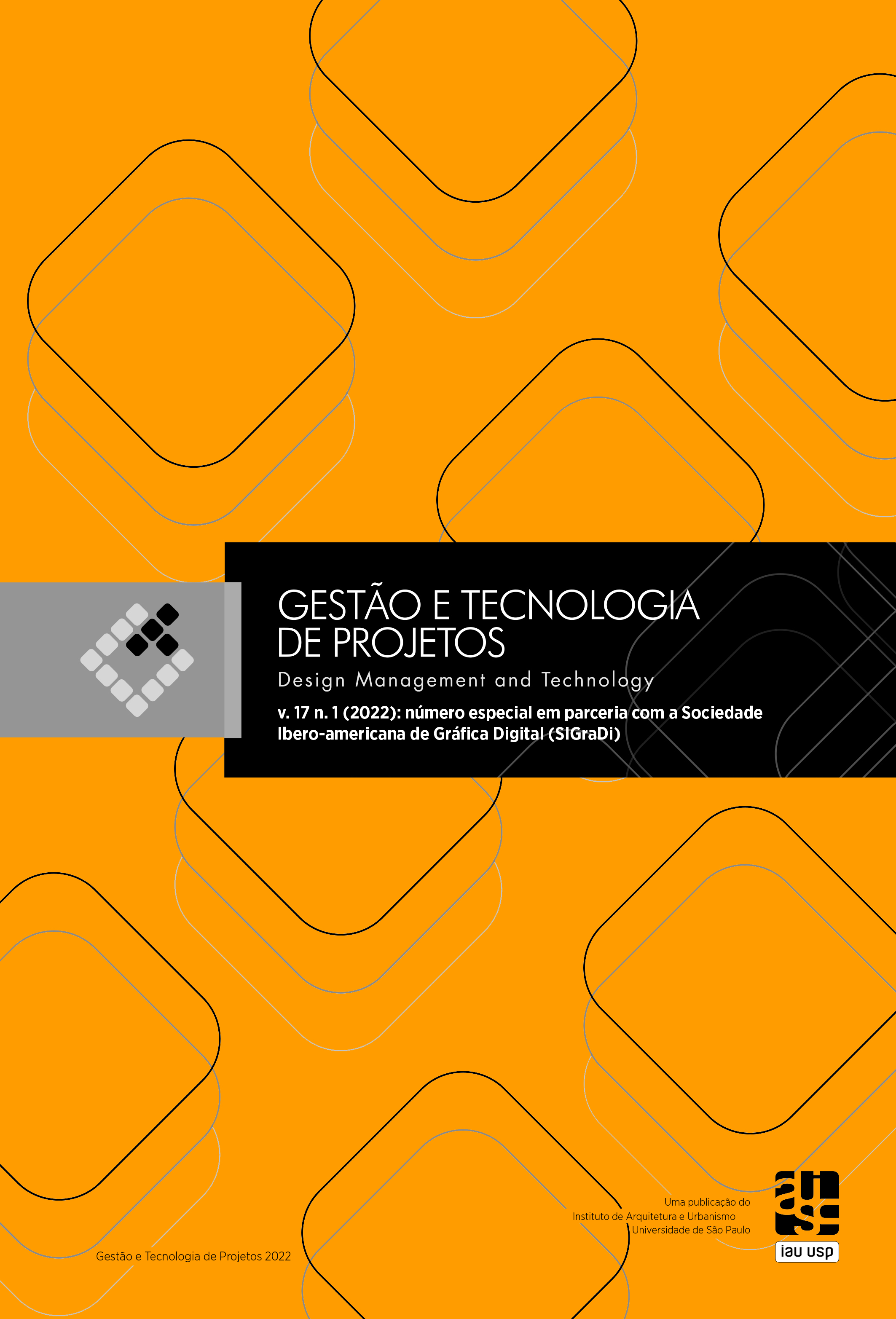Decoding and recoding informal settlements in a design studio: an overview of the world studio project
DOI:
https://doi.org/10.11606/gtp.v17i1.184152Keywords:
Shape grammar, Parametrization, Informal settlement, Urban design, Teaching experienceAbstract
The world is experiencing a surge in its urban population accompanied by rapidly advancing urbanization processes. Contemporary cities are witnessing the rise of numerous urban and social problems, leading, in turn, to the emergence of informal settlements. In response, computational and parametric resources are increasingly being adopted to create innovative and effective approaches to urban planning and design. These resources can be used in informal settlements to improve urban quality without losing their essential features. This paper describes the World Studio, a teaching experience that began in 2017 and continues in the present day, in which undergraduate architecture and landscape architecture students learn how to use shape grammars and parametric tools to design for informal settlements in international contexts (Rio de Janeiro, Brazil, and Ahmedabad, India, to date).
Downloads
References
ALEXANDER, C. A.; ISHIKAWA, S.; SILVERSTEIN, M. Pattern language: Towns, buildings, construction. US: Oxford University Press. 1977.
BARROS, P.; BEIRÃO, J. N.; DUARTE, J. The language of Mozambican slums: Urban integration tool for Maputo’s informal settlements. In: PROCEEDINGS OF THE 31ST CONFERENCE ON EDUCATION IN COMPUTER AIDED ARCHITECTURAL DESIGN IN EUROPE. 2:712–24. Delft, The Netherlands. 2013.
(omitido para avaliação). (omitido para avaliação). In: PROCEEDINGS OF THE 37TH ECAADE AND 23RD SIGRADI CONFERENCE. SOUSA, J.P.; XAVIER, J.P.; GONCALO CASTRO HENRIQUES (Ed.) 2:349–58. Porto, Portugal. 2019.
COMPANS, R. A Cidade contra a favela: A nova ameaça ambiental (The city against the favela: the new environmental threaten). Revista Brasileira de Estudos Urbanos e Regionais, v. 9, n. 1, p. 83–99, 2007. https://doi.org/10.22296/2317-1529.2007v9n1p83.
DAVIS, M. Planet of slums. London and New York, NY: Verso, 2006.
DUARTE, J.; BEIRÃO, J. N. Towards a methodology for flexible urban design: Designing with urban patterns and shape grammars. Environment and Planning B: Planning and Design, v. 38, n. 5, p. 879–902. 2011.
DUARTE, J.; BEIRÃO, J. N.; GIL, J. City induction: Formulating, generating, and evaluating urban plans. In: Muller, S.; Arisona, P. W.; Aschwanden, G.; Alatash, J. H. (Ed.). Communications in computer and information science (CCIS). Berlin, Heidelberg, Germany: Springer. 2012. 242, p. 79–104.
DUARTE, J. P.; ROCHA, J. M.; SOARES, G. D. Unveiling the structure of the Marrakech medina: A shape grammar and an interpreter for generating urban form. Artificial Intelligence for Engineering Design, Analysis and Manufacturing, v. 21, n. 4, p. 317–49. 2007. https://doi.org/10.1017/S0890060407000315.
ELOY, S.; DUARTE, J. A transformation grammar for housing rehabilitation. Nexus Network Journal, v. 13, n. 1, p. 49-71. 2011.
GOUVERNEUR, D. Planning and Design for Future Informal Settlements: shaping the Self-Constructed City. London: Routledge. 2015.
KNIGHT, T. Transformations of De Stijl art: The paintings of Georges Vantongerloo and Fritz Glarner. Environment and Planning B: Planning and Design, v. 16, n. 1, 51–98. 1989. https://doi.org/10.1068/b160051.
———. Regarding rules: From Rimini to Rio. Joelho, v. 5, p. 13–27. 2014.
LALL, S.; WANG, H. G.; DA MATA, D. 2006. Do Urban Land Regulations Influence Slum Formation? Evidence from Brazilian Cities. Washington DC: World Bank, Instituto de Pesquisa Economica Aplicada (IPEA). Daniel.
LOPES, G; AMORIM, V.; CAVALLIERI, F. Favelas cariocas: Comparação das áreas ocupadas - 2004-2011 (Carioca favelas: a comparison of settled areas - 2004-2011). Coleção Estudos Cariocas. Rio de Janeiro: Prefeitura da Cidade do Rio de Janeiro. 2011.
MAHABIR, R.; CROOKS, A.; CROITORU, A.; AGOURIS, P. The study of slums as social and physical constructs: Challenges and emerging research opportunities. Regional Studies, Regional Science, v. 3, n. 1, p. 399–419. 2016. https://doi.org/10.1080/21681376.2016.1229130.
MARICATO, E. Metrópole periférica, desigualdade social e meio ambiente (Peripheral metropole, social inequality, and environment). In: VIANA, G.; SILVA, M.; DINIZ, D. (Ed.). O desafio da sustentabilidade: Um debate socio-smbiental no Brasil. Sao Paulo: Fundacao Perseu Abramo. 2001.
PATEL, B.; BYAHUT, S.; BHATHA, B. Building regulations are a barrier to affordable housing in Indian cities: The case of Ahmedabad. Journal of Housing and the Built Environment, v. 33, n. 1, 1 p. 75–95. 2018. https://doi.org/10.1007/s10901-017-9552-7.
PREFEITURA DE SÃO PAULO. Direito à cidade (Right to the City). Cadernos de Formação. São Paulo, Brazil: Prefeitura de São Paulo. 2015.
SAATH CHARITABLE TRUST. 2020. Integrated Area Development for Vatva, Ahmedabad, AHMEDABAD - Concept Note.
STINY, G. Shape: Talking about seeing and doing. Cambridge, MA, US: MIT Press. 2006.
STINY, G.; GIPS, J. Shape grammars and the generative specification of painting and sculpture.
TEELING, C. Algorithmic design: Generating urban form. Urban Design Studies v. 2 p. 89–100. 1996.
UNITED NATIONS. Transforming Our World: The 2030 Agenda for Sustainable Development. United Nations. https://sdgs.un.org/2030agenda. 2015.
———. 2020. The Sustainable Development Goals Report 2020. United Nations. https://unstats.un.org/sdgs/report/2020/The-Sustainable-Development-Goals-Report-2020.pdf.
(omitido para avaliação). (omitido para avaliação). PhD thesis, State College: The Pennsylvania State University. 2020.
———. (omitido para avaliação) Environment and Planning B: Urban Analytics and City Science 0 (online first) (January): 1–18. https://doi.org/10.1177/2399808319897625. 2020b.
Downloads
Published
Issue
Section
License
Copyright (c) 2021 Débora Verniz, Fernando Lima, José P. Duarte

This work is licensed under a Creative Commons Attribution-NonCommercial-NoDerivatives 4.0 International License.
Copyright Notice
Authors who publish in this journal agree to the following terms:
- Authors retain the copyright and grant the journal the right of first publication, with the article simultaneously licensed under the Creative Commons Attribution License BY NC ND, which allows the sharing of article with acknowledgment of authorship and initial publication in this journal.
- Authors are authorized to take additional contracts separately, for non-exclusive distribution of version of the article published in this journal (e.g. publish in institutional repository or as a book chapter), with acknowledgment of authorship and initial publication in this journal.
- Authors are allowed and encouraged to publish and distribute their research work online (e.g. in institutional repositories or on their personal page) at any point before or during the editorial process, as this can generate productive changes, as well as increase the impact and the citation of published article (See O Efeito do Acesso Livre).



